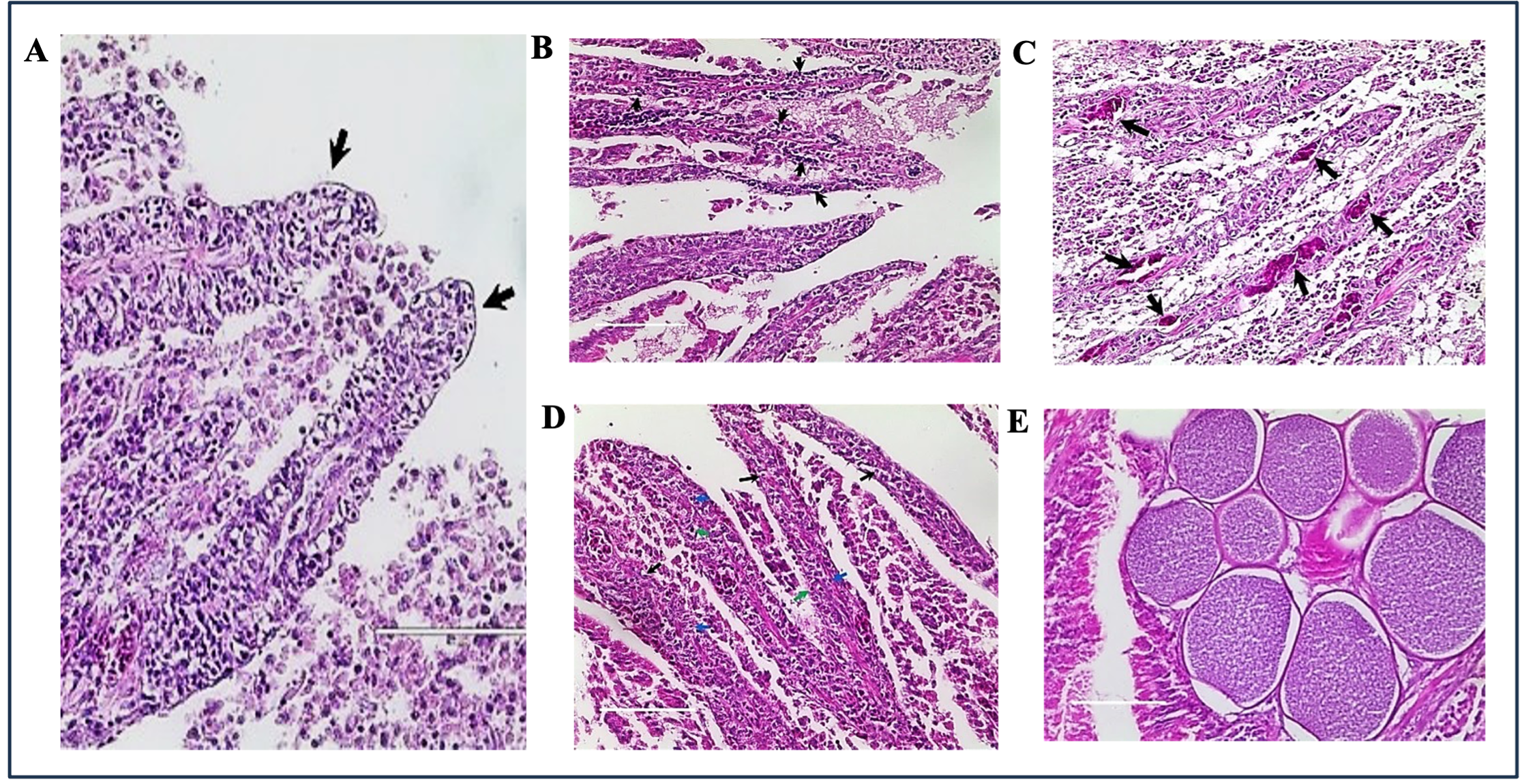Histopathological features of the small intestines and quantification of lactic acid bacteria of broiler chickens supplemented with plectasin
DOI:
https://doi.org/10.1590/1809-6891v25e-78210EAbstract
This study was conducted to determine the histopathological features of the small intestines and to quantify lactic acid bacterial population in the ceca of broiler chickens supplemented with varying doses of plectasin, an antimicrobial peptide with gut health- promoting potentials. This research was done by supplementing broiler chickens with varying doses (150 ppm, 300 ppm and 450 ppm) of plectasin alongside negative and positive control groups. Small intestinal samples showed decreased occurrence and severity of histopathological lesions from the duodenum to the ileum. The occurrence of duodenal lesions such villi necrosis, de- epithelization of villi, haemorrhage and inflammation, observed in the duodenum decreased with supplementation of plectasin, which demonstrated its potential in promoting the structural integrity of the small intestines. On the other hand, microbial enumeration resulted in lower total lactic acid bacteria count in treatment groups supplemented with plectasin, demonstrating its inability to enhance beneficial microbiota, but may be suggestive of improved intestinal absorptive capacity based on the concept of competitive exclusion.
Downloads
References
Kasimanickam V, Kasimanickam M, Kasimanickam R. Antibiotics Use in Food Animal Production: Escalation of Antimicrobial Resistance: Where Are We Now in Combating AMR? Med Sci (Basel, Switzerland). 2021;9(1).
Zhou X, Wang J, Lu C, Liao Q, Gudda FO, Ling W. Antibiotics in animal manure and manure-based fertilizers: Occurrence and ecological risk assessment. Chemosphere [Internet]. 2020;255:127006. Available from: https://doi.org/10.1016/j.chemosphere.2020.127006
Wang S, Zeng X, Yang Q, Qiao S. Antimicrobial peptides as potential alternatives to antibiotics in food animal industry. Int J Mol Sci. 2016;17(5).
Hao Y, Teng D, Mao R, Yang N, Wang J. Site Mutation Improves the Expression and Antimicrobial Properties of Fungal Defense. Antibiotics. 2023;12(8).
Oladokun S, Sharif S. Exploring the complexities of poultry respiratory microbiota: colonization, composition, and impact on health. Anim Microbiome [Internet]. 2024;6(1). Available from: https://doi.org/10.1186/s42523-024-00308-5
Gibson-Corley KN, Olivier AK, Meyerholz DK. Principles for Valid Histopathologic Scoring in Research. Vet Pathol. 2013;50(6):1007–15.
Abdul-Aziz T, Fletcher OJ, Barnes HJ, Shivaprasad HL, Swayne DE. Avian histopathology: 4th Edition [Internet]. American Association of Avian Pathologists. 2016. p. 654. Available from: https://www.aaap.info/avian-histopathology
Fathima S, Shanmugasundaram R, Adams D, Selvaraj RK. Gastrointestinal Microbiota and Their Manipulation for Improved Growth and Performance in Chickens. Foods. 2022;11(10):1–30.
Kai Y. Intestinal villus structure contributes to even shedding of epithelial cells. Biophys J [Internet]. 2021;120(4):699–710. Available from: https://doi.org/10.1016/j.bpj.2021.01.003
Wang J, Liu S, Ma J, Piao X. Changes in Growth Performance and Ileal Microbiota Composition by Xylanase Supplementation in Broilers Fed Wheat-Based Diets. Front Microbiol. 2021;12(July).
Hu F, Gao X, She R, Chen J, Mao J, Xiao P, et al. Effects of antimicrobial peptides on growth performance and small intestinal function in broilers under chronic heat stress. Poult Sci. 2017;96(4):798–806.
Quinteiro-Filho WM, Rodrigues M V., Ribeiro A, Ferraz-de-Paula V, Pinheiro ML, Sá LRM, et al. Acute heat stress impairs performance parameters and induces mild intestinal enteritis in broiler chickens: Role of acute hypothalamic-pituitary-adrenal
axis activation. J Anim Sci. 2012;90(6):1986–94.
Song J, Xiao K, Ke YL, Jiao LF, Hu CH, Diao QY, et al. Effect of a probiotic mixture on intestinal microflora, morphology, and barrier integrity of broilers subjected to heat stress. Poult Sci. 2014;93(3):581–8.
Gieryńska M, Szulc-Dąbrowska L, Struzik J, Mielcarska MB, Gregorczyk-Zboroch KP. Integrity of the Intestinal Barrier: The Involvement of Epithelial Cells and Microbiota—A Mutual Relationship. Vol. 12, Animals. 2022. 1–32 p.
Jutfelt F. Barrier Function of the Gut. Encycl Fish Physiol From Genome to Environ [Internet]. 2011;2(January 2011):1322–31. Available from: http://dx.doi.org/10.1016/B978-0-12-374553-8.00068-X
Mygind PH, Fischer RL, Schnorr KM, Hansen MT, Sönksen CP, Ludvigsen S, et al. Plectasin is a peptide antibiotic with therapeutic potential from a saprophytic fungus. Nature. 2005;437(7061):975–80.
Angelov A, Georgieva A, Petkova M, Bartkiene E, Rocha JM, Ognyanov M, et al. On the Molecular Selection of Exopolysaccharide-Producing Lactic Acid Bacteria from Indigenous Fermented Plant-Based Foods and Further Fine Chemical Characterization. Foods. 2023;12(18).
Lan PTN, Binh LT, Benno Y. Impact of two probiotic Lactobacillus strains feeding on fecal lactobacilli and weight gains in chicken. Vol. 49, Journal of General and Applied Microbiology. 2003. p. 29–36.
Nazef L, Belguesmia Y, Tani A, Prévost H, Drider D. Identification of lactic acid bacteria from poultry feces: Evidence on anti-Campylobacter and anti-Listeria activities. Poult Sci. 2008;87(2):329–34.
Apajalahti J, Vienola K. Interaction between chicken intestinal microbiota and protein digestion. Anim Feed Sci Technol [Internet]. 2016;221:323–30. Available from: http://dx.doi.org/10.1016/j.anifeedsci.2016.05.004
Ma JL, Zhao LH, Sun DD, Zhang J, Guo YP, Zhang ZQ, et al. Effects of Dietary Supplementation of Recombinant Plectasin on Growth Performance, Intestinal Health and Innate Immunity Response in Broilers. Probiotics Antimicrob Proteins. 2020;12(1):214–23.

Downloads
Published
How to Cite
Issue
Section
License
Copyright (c) 2024 Brazilian Animal Science/ Ciência Animal Brasileira

This work is licensed under a Creative Commons Attribution 4.0 International License.
Authors who publish with this journal agree to the following terms:
- Authors retain copyright and grant the journal right of first publication with the work simultaneously licensed under a Creative Commons Attribution License that allows others to share the work with an acknowledgement of the work's authorship and initial publication in this journal.
- Authors are able to enter into separate, additional contractual arrangements for the non-exclusive distribution of the journal's published version of the work (e.g., post it to an institutional repository or publish it in a book), with an acknowledgement of its initial publication in this journal.
- Authors are permitted and encouraged to post their work online (e.g. in institutional repositories or on their website) prior to and during the submission process, as it can lead to productive exchanges, as well as earlier and greater citation of published work (See The Effect of Open Access).































